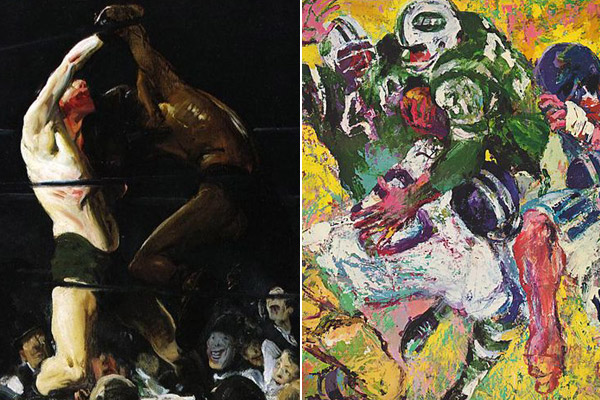LeRoy Neiman, who cut his teeth under SAIC prof and Russian émigré Boris Anisfeld—you can see the influence—as a GI Bill student and went on to become one of the biggest pop successes in the American art world, died yesterday at 91. His influence has waned a bit, so it's hard to explain to the kids just how ever-present his work was for so long, but Jerry Saltz's description is a good start.
I mainly saw Neiman's work incidentally, in the pages of my father's Playboys, furtively fumbling through for pictures of big American breasts. (Which might mean that LeRoy Neiman is a kind of unnamed fetish to millions of boys who grew up speeding past his illustrations to get to the good stuff.) His style was a mismatched gaudy mash-up of Abstract Expressionism, action painting, School of Paris painting, Raoul Dufy, George Bellows, Oskar Kokoschka, and familiar illustrational sketchiness, all done with a garish semi-psychedelic pop color and quick if sometimes sleazy slapdash splash.
The day Neiman died, I read "Young and Gifted," Peter Schjeldahl's piece about a George Bellows retrospective at the National Gallery in D.C. If a sports painting has been viewed more times than any of Neiman's portraits of Joe Namath or Michael Jordan, it's probably Bellows's Stag at Sharkey's.
Bellows was a prodigy, scoring quick successes with [Robert] Henri-like portraits, scenes of slum life, and, especially, boxing pictures. His most famous painting, "Stag at Sharkey's" (1909), is also his finest: fighters slamming into each other, rendered with brushwork so eloquent—fast, sensuous, subtle—as to feel prophetic of Willem de Koonig.
[snip]
At the time, boxing was illegal in New York, except in clubs, such as Tom Sharkey's Athletic Club, whose "members" might include anyone who paid at the door. Queensberry rules appear to have been optional. Bellows said, "I don't know anything about boxing. I am just painting two men trying to kill each other." In one of several fine essays in the show's catalogue, the art historial David Peters Corbett relates the savagery of Bellow's fight scenes to the contemporaneous muckraking of Upton Sinclair, who wrote of hearing, in a Chicago slaughterhouse, "the hog-squeal of the universe…." Their livid flesh, radiating agony, is a marvel of colors blended in wet strokes on the canvas. The picture is at once a snapshot of hell and an apotheosis of painting.
Neiman never did anything anyone would consider an "apotheosis of painting." But in his own way, Neiman captured sport in its time and place as ably as Bellows did his. In 1909, boxing was an underground hell of poverty and violence, the athletic equivalent of Chicago's stockyards. When Neiman became the New York Jets' in-house painter (not making that up) sixty years later, they were led by football's first matinee idol, Broadway Joe Namath. That year Namath won the AFL-NFL World Championship Game, the predecessor to the Super Bowl, and starred in the first Monday Night Football game the following year.
American athletics was no longer a snapshot of hell; it was a pop product of colorful stars, and Neiman, whose star was forged by Hugh Hefner, was there to capture the transformation. As he told NY1, "the people who love my paintings, that respond to them the most, they're spectators, they're not viewers."

On the left, a detail from Bellows's 1909 work Both Members of This Club; on the right, Neiman's 1967 illustration for a Jets program. Bellows captured the violence of a dark, intimate boxing speakeasy; Neiman captured entertainment, the vivid and blurry colors of the years color TV became standard. To put you in the mood of the era, here's that Jets-Browns game that inaugurated Monday Night Football.
And Neiman captured an audience—not just of the spectators, but the men he painted:
He recalls a time when [Shaquille] O'Neal came over while the artist was sketching the basketball star and began quizzing him about the drawing.
"He said, 'I want to know how you did it and why you did it,'" Neiman recalls. "I said, 'What is it that you like about it?' He said, 'You got me fast. I look fast.'"
That's a talent athletes love. The Art Institute's Jones recalls entering a bar with Neiman in Chicago and the place erupting with a roar of recognition. Inside were British boxer Ken Norton and his entourage, as well as defensive backs from the Chicago Bears.
"The bar is filled with these immensely huge men," Jones says. "LeRoy, who is not small, and I are completely lost in this, surrounded by these huge men. And LeRoy is the star."
Neiman was the court painter to a burgeoning American royalty—but not an inherited royalty, one that created itself, like Neiman, out of humble origins. He flattered that nobility, but in doing so, captured that nobility's image of itself, and our image of it.



